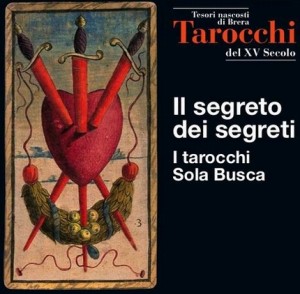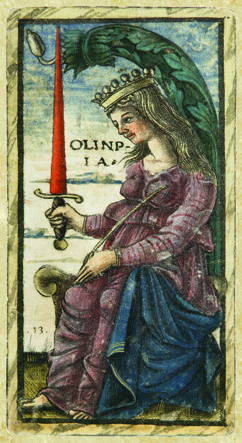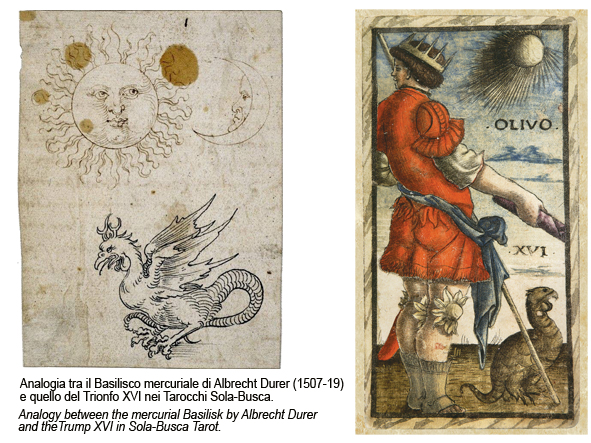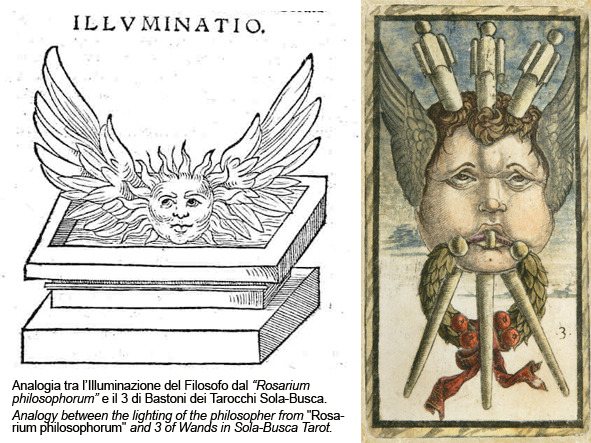With a fundamental study of the Italian esotericist scholar Sofia Di Vincenzo, began in 1995 the symbolic analysis of 56 Minor Arcana of this extraordinary deck, suggesting that it is actually an illustrated treatise that explains the secrets processes of spirituale Alchemy.
Twenty-eight years later, the catalogue of the exhibit The Secret of Secrets. The Sola-Busca Tarot and the hermetic-alchemic culture in the Marche and Veneto at the end of 15th century (Milano, Pinacoteca di Brera, 2012) give important news about alchemical meanings of some pictures of the Sola-Busca Tarot.
PREMISES
Before the prof. Laura Paola Gnaccolini (curator of the mentioned catalogue), the close relations between this mysterious deck and Alchemy had been shown already in 1995 by prof. Sofia Di Vincenzo, in his book Antichi Tarocchi illuminati. L’Alchimia nei Tarocchi Sola-Busca ( Ancient Illuminated Tarot. Alchemy in Tarot Sola-Busca (Turin, 1995; with prefaction by Giordano Berti), published in english by US Games Systems (Stamford, 1998).
In the catalogue of Brera, the work of Sofia Di Vincenzo is quoted only in the bibliography. In fact, this work has characteristics decidedly esoteric (though based on the Jungian typing psychology), while the work done by prof. Gnaccolini has an approach strictly philological.
However, we can consider the Di Vincenzo’s book the first step of one process similar to the interpretation of the Marseillais Tarot started in the late XVIII century with Court De Gebelin and Etteilla; in fact, it was necessary almost 140 years to define the modern significations of the Marseillais Tarot.
So, because the Sola-Busca Tarot was hidden for 500 years, we can suppose that its voyage has started with Sofia Di Vincenzo; she was the first Author to examine the details of the 78 allegories… but any interpretation can be improved, as has happened to the works by Court De Gebelin and Etteilla. In other words, some new scholar could give a new interpretation, in the future, more exhaustive and coherent that than gived by Sofia Di Vincenzo.
Waiting to see published that book, I give here some considerations of prof. Gnaccolini and below the results of my personal research.
SOLA-BUSCA TAROT AND ALCHEMY, by Laura Paola Gnaccolini
Alchemy and Alexander the Great
In the above mentioned catalogue of the exhibit “The Secret of Secrets” , Laura Paola Gnaccolini focuses on the figure of Alexander the Great as King of Swords and some characters related to him.
Alexander belonged to the medieval series of illustrious men: he was one of the so-called “Nine worthies”. The Macedonian King had already been deified in ancient times and he passed on a legend that would reach from the sky on a wagon hauled by Griffins. This legend had a great success in the Middle ages, especially in aristocratic environments.
But there is a medieval text even more interesting; is the “Secretum secretorum”, an exchange of letters between the philosopher Aristotle and his pupil Alexander the Great on astrology, dietetics, Alchemy and other topics aimed at the management of power. Reading the Secretum we learn that the philosopher introduced the student to the mysteries of alchemical knowledge. This news, although it is a medieval legend, throws an illuminating light on the link between the leader and the obscure iconography of the Sola-Busca Tarot that recurs in the suit of coins.
Here are the characters linked to the history of Alexander the Great:
AMONE (Knight of Swords), OLINPIA (Queen of Swords) and NATANABO (Knight of Cups).

AMONE (Knight of swords), refers to Zeus Ammon, the mythical father of Alexander according to the Oracle of Siwah oasis.
It is worth mentioning that, in antiquity, Alexander the Great was hailed as a new Sun, ancient alchemical symbol of gold, the most perfect of metals, privileged matter get the “Lapis philosophorum”.
Another alchemical figure, explained years ago by Sophia Di Vincenzo and resumed briefly by Laura Paola Gnaccolini, is the Trump XVI – OLIVO, illustrating the “triumph of the Sun” (shown at the top right of the card). In the lower right corner there is a basilisk, a mythical entity with the rooster body and tail of a serpent; in this respect, the prof. Gnaccolini notes that in a treatise of the 12th century the German monk Theophilus indicated the basilisk as indispensable ingredient (once reduced powder) to get the “Gold of the Philosophers”.
ALCHEMICAL ICONOGRAPHY AND SOLA-BUSCA TAROT, by Giordano Berti
Because, very often, the images speak more than words, I propose here some results of my personal research: a comparative vision of the similarities that exist between some alchemical allegories and figures of the Sola-Busca Tarot.












I absolutely love these
LOVE LOVE LOVE
I love it – such beatiful cards & symbols and meaning. I will wait for your study of the connection to Alchemy
Rina segev – ISrael
I enjoyed this and I love it too. The Ace of disks threw me off, I didn’t recognize it, I thought it was the world, so thank you.